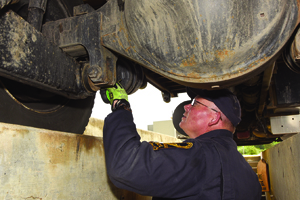Fleets Use Technology to Track, Improve CSA Scores

This story appears in the September 12 print edition of iTECH, a supplement to Transport Topics.
Carriers are using a variety of technologies and in-house systems to help monitor and improve their scores under the federal Compliance, Safety, Accountability program.
Werner Enterprises uses software from Transportation Performance Inc. to analyze data and has formed an analytics team that further dissects the information to provide a clear indication of where the company should focus its efforts.
“This helps us see what is the most important and the most immediate,” said Jaime Mause, vice president of safety and compliance at Werner.
BEST OF SEPTEMBER iTECH: More stories, columns
Providing timely feedback to drivers plays an important role in addressing any problems, she added.
“Giving them more information to help them learn about it and prevent it helps with the long-term reduction in violations,” Mause said.
Werner, based in Omaha, Nebraska, ranks No. 15 on the Transport Topics Top 100 list of the largest for-hire carriers in the United States and Canada.
C.R. England Inc. uses scorecards that it reviews with drivers to improve safety, said Derek Ohata, director of compliance.
“We say this is your professional driving résumé. Everybody knows what a résumé is and how powerful it can be,” Ohata said. “You could talk until you’re blue in the face, but until you can show them something they can touch, feel or see, they may not understand.”
Drivers who receive violations can be assigned training modules they can complete through C.R. England’s learning management system. The Salt Lake City-based carrier ranks No. 23 on the for-hire TT00.
Penske Logistics, based in Reading, Pennsylvania, also utilizes software to help monitor CSA scores and reviews the data to identify trends at both a location and driver level.
“The biggest advantage of this technology is that it enables us to understand which locations and drivers are impacting company scores, and that is a valuable tool in helping us with internal coaching to improve both individual performance and our overall score,” said Dennis Abruzzi, senior vice president of safety for Penske Logistics, which ranks No. 22 on the for-hire TT100.
J.J. Keller & Associates, a provider of resources and technology to help fleets ensure regulatory compliance, plans to add a feature later this year that will enable carriers to assign training to drivers based on their violations or critical events, said Tom Bray, a senior editor for the company.
J.J. Keller also is rolling out Driver DataSense, which aggregates hours-of-service data from onboard technology, paper logs and time sheets.
“That allows you to see problems before your drivers get out on the road and get violations,” Bray said.
Ryder System Inc. links driver coaching to trends it uncovers via technology, said Andrew Leavitt, senior safety and loss prevention manager. Data analytics services help carriers identify trends and can show what exists based on geographical area, weather patterns, the type of vehicle and driver profile, he said.
“We tend to look at groups of drivers and their corresponding management,” Leavitt said. “You see often that it is usually an issue where there is a new manager or high turnover of drivers.”
Additional technologies such as onboard video can aid in driver coaching, Leavitt added.
Ryder System is the parent company of Ryder Supply Chain Solutions, No. 13 on the for-hire TT100.
By identifying behavior patterns, carriers can sit with the driver, share the video, discuss issues and help drivers understand how to improve, said Del Lisk, vice president of safety services for Lytx Inc., provider of the DriveCam video-based safety system.
Lytx also provides detailed CSA and safety information to carriers as part of its Rair compliance services. Lytx pulls in data from multiple streams, including roadside inspections, aggregates them and audits the information to verify that it is accurate and current. Carriers can check their scores daily rather than having to wait for the monthly update from CSA.
“If the algorithm says the scores are getting worse, they can be proactive,” Lisk said, adding that the technology helps carriers zero in on any problems in their operations. “The challenge for carriers is they get a huge amount of data, and it is hard to see the forest through the trees.”
Drivewyze offers a program that allows carriers to bypass weigh stations based on their safety scores. In addition to saving drivers time, the company’s PreClear system also can prevent accidents, the company said.
“In general, the less congestion you have at inspection sites or weigh stations, the less safety risk there is,” Drivewyze President Brian Heath said.
Clean roadside inspections allow carriers to improve CSA scores, but they can be time-consuming. Drivewyze is preparing to launch a field trial of a system that will expedite Level 3 inspections by automatically and wirelessly populating an inspection form with data such as driver and hours-of-service information, according to the company.
“You can turn a 30- to 60-minute manual inspection into a five-minute inspection,” Heath said, adding that it could help carriers looking to increase clean inspections get them faster. ³

